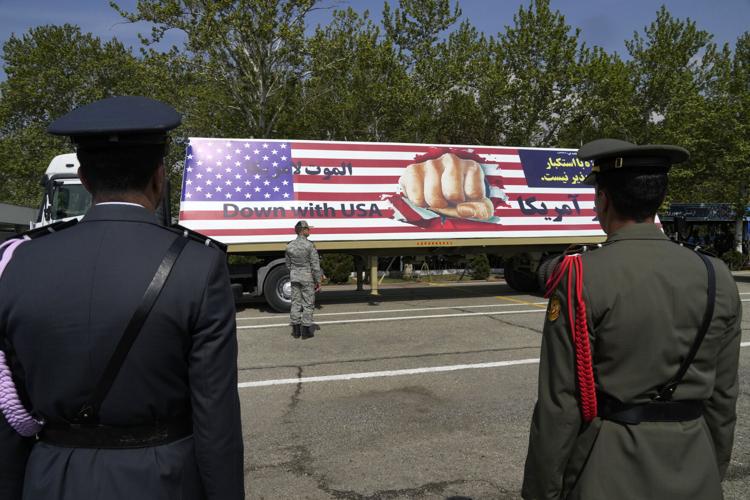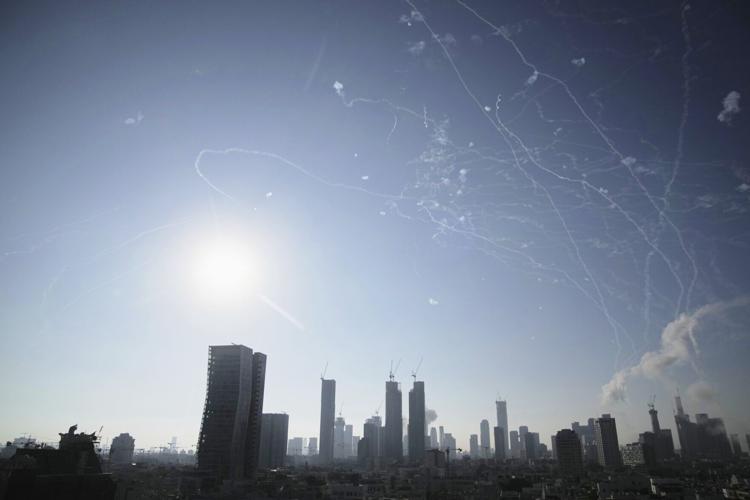The aftermath of U.S. attack on Iran may hold the most peril | Vince Bzdek
As the U.S. once again makes the most serious decision a country can make — going to war — let’s pray our leaders have fully considered the day after.
Now that the U.S. has come to Israel’s aid in its attack on Iran, sending our bombers and bunker-busting bombs to take out Iran’s underground nuclear enrichment facility, the aftermath may hold the most peril.
Certainly making sure Iran doesn’t have nuclear weapons could make the world safer.
But there are 40,000 reasons to worry about the days immediately after the U.S strike, 40,000 being the number of U.S troops stationed in the Middle East.
Living in a military community, it’s hard for us here in Colorado Springs not to focus on the individual soldiers who may be impacted by the decision to join the attack. The calculus is made up of real people for us.
How do you feel about the U.S. striking nuclear sites in Iran?
To be cognizant of the possible risks and fallout doesn’t mean we necessarily should not have gone to war, it just means those things should be part of the cost/benefit analysis going forward. So many times in the past — Iraq, Afghanistan, Vietnam — we have not had our eyes fully open as we have marched off to war.
“A strike could seriously damage Iran’s nuclear and military infrastructure, delay its weapons program, and weaken its proxy network,” said Micheline Ishay, director of the Center for Middle East Studies at DU’s Korbel School of International Studies. “It would also send a strong signal — to Iran and other adversaries — that the U.S. is still willing to act when its interests or allies are threatened. That could initially protect people from countries like Saudi Arabia, the UAE and Jordan, and maybe even bring Iran back to the negotiating table — but from a weaker position.
“But let’s be clear: the long-term risks are significant,” added Ishay. “A U.S.-Israel strike could trigger a major regional war. Iran would likely respond through its proxies in Lebanon, Iraq, Syria and Yemen, putting U.S. troops, embassies, and allies in the crosshairs. Fragile states could unravel, and the U.S. might get dragged into another long and costly conflict — something it’s tried hard to avoid.”
U.S. troops
The most immediate risk is a counterstrike against U.S. troops in the Mideast.
We have thousands of troops stationed in Kuwait, Qatar, Bahrain, Iraq, Syria and the United Arab Emirates. The biggest single U.S. military site is Al Udeid Air Base in Qatar, the regional headquarters for the U.S. Central Command, which oversees forces in the region. About 10,000 American soldiers are based there.
Iranian Defense Minister Aziz Nasirzadeh warned this month, “All U.S. bases are within our reach and we will boldly target them.”
Soon there will also be two aircraft carriers in the region, the USS Nimitz and the USS Carl Vinson. Between the two of them they carry more than 10,000 additional troops.
Strikes on U.S. bases in the Mideast have precedent. In January 2020, Iran launched 13 ballistic missiles at U.S. troops in Iraq, wounding about 100. The attack was in response to the U.S. drone strike that killed Gen. Qasem Soleimani, leader of Iran’s elite Quds Force.
What are the other likely threats to Americans now that we have attacked Iran?
Terror
Iran also has lots of experience with terrorism. The U.S. attack could prompt Tehran to unleash its “Axis of Resistance” militias and Islamic Revolutionary Guard Corps sleeper cells globally.
Karl Schneider, a former Green Beret and past chair of the World Affairs Council who has seen combat in Iraq and Afghanistan, has had direct encounters with the Guard in Iraq and Turkey.
“The danger with U.S. involvement near term is that the IRGC is extremely capable and we can expect insurgent/guerilla type tactics throughout the Middle East and Europe with some sympathetic activity here in the U.S.,” the Colorado Springs resident said.
Proxy groups
After Israel’s war in Gaza began in fall 2023, Iran-backed proxy groups launched more than 180 attacks on U.S. soldiers in the region. The proxy troops fired drones and other weapons at U.S. positions, according to the Foundation for Defense of Democracies.
Straight of Hormuz
One-fifth of the world’s oil travels on ships through the Strait of Hormuz between the Persian Gulf and the Gulf of Oman. Attacks on oil tankers in the straight are under serious consideration, according to Iranian state media.
“Iran could cripple the fuel flowing through the Straits of Hormuz and, even if the Iranian Regime were to fall, it would take weeks if not months to ‘clear’ the straits,” said Schneider. “Oil and gas prices will skyrocket. Iran could take out Saudi oil fields, too, at Dharan, and further exacerbate oil issues.”
Iran also has threatened to seed the strait with as many as 6,000 mines, a tactic meant to pin American warships back in the Persian Gulf.
War of attrition
Tehran could take a page from the Iraq and Afghan wars and launch a long war of attrition, where it tries to exhaust U.S. will or capacity to fight in a drawn-out confrontation that could last the duration of Donald Trump’s presidency.
“For the U.S., I am very concerned by the appearance of our efforts to topple another Middle Eastern regime,” Schneider said. “How has that worked out for Afghanistan, Iraq or Libya? The latter is still in the midst of a civil war that will continue.”
Nuclear backfire
If the U.S. successfully took out the enrichment facility at Fordo, it would be a serious blow — it’s one of Iran’s most protected and secret sites, buried deep underground. “But Iran’s nuclear program isn’t limited to just one facility,” Ishay said. “It’s spread out across multiple sites, backed by stockpiles, scientific expertise and decades of technical knowledge. You can bomb a building, but you can’t bomb what people know.
“So, destroying Fordow might delay the program — maybe for a few years — but it wouldn’t stop it entirely,” she cautions. “And ironically, it could backfire. Iran might double down, rebuild with more urgency, and rally more domestic support. Without a diplomatic track to follow up, one is just buying time — not ending the story.”
Hostages
Let’s not forget that it was Iran that crippled the Jimmy Carter presidency by seizing the U.S. embassy in Tehran in 1979 and holding 52 American diplomats and citizens hostage for 444 days.
Another country in chaos
“If the regime falls, sure bombs will stop falling on Israel and other Arab states will feel Iran’s influence subside but Iran may be plunged, as most Middle Eastern states seem to have, into a tribal abyss that will take decades to extract itself from,” noted Schneider.
Ishay agrees: “Politically, a strike could empower Iran’s hardliners, weaken reformists, and radicalize younger generations across the region — fueling another wave of militancy and instability.
“And if all this unfolds without a serious, simultaneous push for a diplomatic or peace process, the consequences could be even more destabilizing. Without a path forward, military action risks becoming just another cycle of violence with no off-ramp, making a long-term solution even harder to reach.”
Embolden China
Seeing the dominoes fall and the proverbial writing on the wall, China may decide to act on Taiwan while the U.S. is actively engaged in the Mideast. Currently, three of our 11 carrier groups are in the Mideast, and two are in dry dock so one-third of our “force projection platforms” are focused on the Middle East, notes Schneider.
Attacks on homeland
As the U.S. enters this war, the danger won’t just be “over there.” It could come home in ways we’re not fully prepared for, said Ishay.
Iran reacted to the U.S.-Israeli cyberattack on its nuclear program 15 years ago by building a cyber-corps that is capable of considerable damage.
“Cyberattacks are a big concern,” said Ishay. “They’ve already targeted U.S. banks, water systems and other infrastructure. In a full-blown conflict, we’d likely see more of that — attacks that could disrupt daily life here.”
U.S. intelligence has warned about sleeper networks, and we’ve already seen plots against officials like John Bolton and Mike Pompeo, Ishay added. “While a large-scale attack is unlikely, soft targets — like community centers or high-profile individuals — could be at risk.”
U.S. Sen. Richard Blumenthal, D-Conn., a member of the Armed Services Committee, recently said Iran may have the ability to mount drone attacks from within the United States. He pointed to Ukraine’s devastating drone attack on Russian warplanes 3,000 miles inside its border. Israel, too, used drones smuggled into Iran as part of its recent attack.
In addition to all these scenarios, there are all the “known unknowns and unknown unknowns” that we don’t know about yet, as the late former defense secretary Donald Rumsfeld used to say in the context of the Iraq War.
“Bottom line: Iran can’t be allowed to go nuclear — but stepping in could unleash a cascade of unpredictable and dangerous consequences,” Ishay said.
Going to war should rightfully be the hardest decision we ever make. As we enter into a war with Iran, I keep hearing the words of Douglas MacArthur that were shared with me by my grandfather, a lifelong soldier and veteran of World War II and Korea:
“The soldier above all others prays for peace, for it is the soldier who must suffer and bear the deepest wounds and scars of war.”
Vince Bzdek, executive editor of The Gazette, Denver Gazette and Colorado Politics, writes a weekly news column that appears on Sunday.







